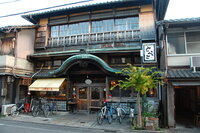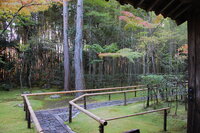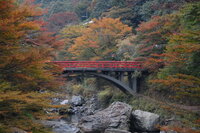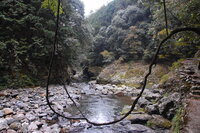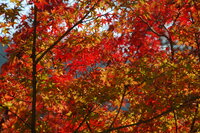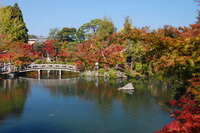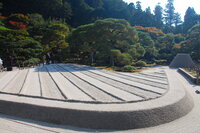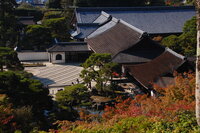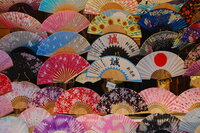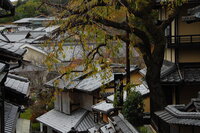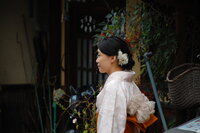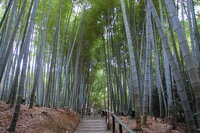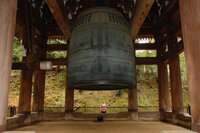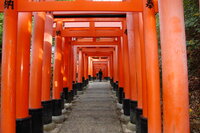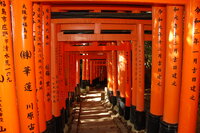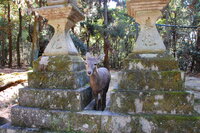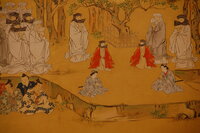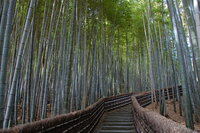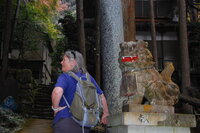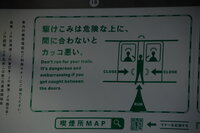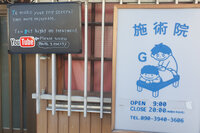Kanazawa was pretty busy whilst we were there, but on the day we left it was eerily quiet. Megan
had spotted during her extensive trip planning that this was Culture Day, but of course we didn't
really know what that implied. One thing it did imply is that our carefully planned bus to go to
the station didn't turn up, as they were running on a holiday schedule. No drama, that just meant we
just had a little way less time to eat croissant at the station.
Leaving Kanazawa, we took Thunderbird 18 to Kyoto. This train did not really live up to its name,
except that it did seem to be staffed by puppets robots. We already mentioned that
the guards bow when they enter or leave a carriage. We assume this happens in all the carriages and
not just ours, but it's certainly a nice touch. Thunderbird 18 is not a bullet train (unless you are
from the UK, in which case all Japanese trains are bullet trains) but it still only took a couple of
hours and one box of raw fish eaten with sticks to get to Kyoto.
Kyoto
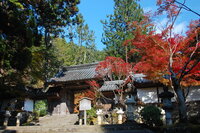
Kyoto is a city made of culture, which is why we are here for a week (we are cultured people after all). Sadly, the rest of the world seems to think so too including every single Japanese person that exists. Kyoto station was absolutely manic. We had planned to leave our bags in the storage lockers, which were conveniently located but inconveniently full. Consequently, we had to fight through the station and find and navigate the subway system to get to the hotel to drop our bags. We couldn't check in yet even though there wasn't a single dinosaur on the check-in desk. It was getting a bit hot and humid by this point, so we decided to jump back on the subway, go up town and then hoof it across town to see a shrine. Why wouldn't you? We didn't have a lot of time that day and due to the aforementioned heat, we actually ended up in a rather picturesque café. Oddly for a place so traditional and steeped in history, we had to scan a QR code and do our own ordering much to Steve's displeasure. Sometimes, tech for the sake of it is just counter productive, pointless and irritating. Especially when it doesn't work properly [end of rant].
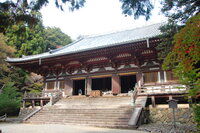
Having come half way round the world to visit the cultural centre of Japan, we immediately jumped on a little local bus and took a trip out of the city into the hills to do some walking. The bus driver kept giving us weird looks as we resolutely refused to get off his bus at all the usual tourist attractions. Still, he was driving as safely as possible (according to the frequent automated announcements). Who doesn't like a bus driver who wears pristine white cotton gloves and who points to each of the seven mirrors as he checks them before moving off from each stop? Fantastic! The purpose of this excursion was to walk some of the Kiyotaki River, specifically from Takao to Hozukyō Station. It's about 10 miles and takes in the Buddhist Temples of Saimyō-ji and Jingo-ji. We are rapidly forming the opinion that these Buddhist types are very astute when it comes to extracting money, which is not to detract from the religion, but it is rather surprising given how traditional they are. Then again, religion and money are not such strange bedfellows.
Many people know of Japan and its cherry blossom and the peak time for visiting is definitely Spring. However, the second most popular time is Autumn when the leaves all turn. It is obviously impossible to time accurately (we booked our flights back in January), but we do seem to be seeing some pretty spectacular displays of Autumnal colour. It is not quite peak time (Autumn is late this year), which is a good thing because it can get properly busy with locals when the official announcement is made that Autumn is in full swing. The walk was very enjoyable if rather tiring as there was a lot of up and down, not least all the steps up to the temples!
These Buddhists really seem to have it sorted. Since all their temples are made of wood, they
make everyone take their shoes off to enter. We already noted in Matsumoto how slippery the stairs
get, but we reckon the fact that this contributes to the polishing of the boards is no accident.
They also have a strict rule about no photography within their temples which is why we have so few
pictures of something we are spending so much time and effort to visit. It also means that
there's a nice line in postcards available in the inevitable grift gift shop.

We spent a full day exploring temples. We had an itinerary planned, but it was rather thwarted by an "incident involving injury" on the train line. We can only assume that the extensive announcements in Japanese were some kind of extended apology for the resultant shocking unreliability of the service. Part of our walk around the temples involved a couple of km along what is known as the Philosopher's Walk. Despite its romantic name and idyllic setting, Megan described it as "a bit disappointing and just a trudge along a canal". What can you do? For lunch, we stopped in a roadside café run by a little old Japanese couple who proceeded to serve us ham and cucumber sandwiches with the crusts cut off! Their delivery was dead-pan too! A little later, Steve found a stall selling "curry buns". Imaging a doughnut with the jam filling replaced by curry and then the whole thing deep fried in front of you. Who wouldn't like that [apart from Megan]? During our extensive temple visiting, we observed that the Japanese seem pathologically unable to have their photograph taken without making the Churchillian victory symbol. Still, they do have an affinity for the camera, so who is to question them?
All of these temples sport the obligatory moss garden. They are rather pretty places, but one does feel a little short-changed since we have one of these at home and we are here to tell you that it takes little to no maintenance. It's hard to know what the Buddhist entry fee is for (especially if you ignore all the high-end Lexuses parked around the back). Some temples also have gravel gardens which is a novelty. Apparently, in the olden days, not only were they decorative and meditative, but they also served to reflect sunlight into the buildings before the introduction of electricity. Savvy eh? Put all this gravel together with the autumnal trees and there are more Makita leaf blowers in Kyoto here than everywhere else combined.
One place worthy of specific note that we visited was Sanjūsangen-dō which is yet another Buddhist temple. This one dates from 1164 and has 1001 life-size figures of the goddess Kannon. Quite an impressive sight to see them lined up in rows and fronted by 30 gods. Again no pictures, but it certainly did contain "a load of gold coloured dudes". We visited this temple by bus and were pleased to discover that there was a man at the bus stop in uniform whose job it was to dispense bus-related advice to anyone who might need it. More pleasing was the fact that he was wearing the pristine white cotton gloves we are coming to expect. Most pleasing was that he bowed to the bus as it arrived.
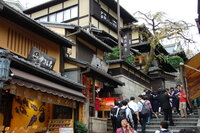
We dined out in Ponto-chō, which is the trendy part of Kyoto according to Megan. Nevertheless, they let us in. Shoes off before we could sit at the table and then we had to navigate the supplied tablet app to order our food and drink. Easier in some respects, but infuriating in others. Still, we got what we asked for and in record time. The screen-saver hadn't even come on before our drinks arrived. The area is home to the geisha houses, but also features hundreds of bars, brothels and cheap places to eat. It is also rammed with people at night. What makes it a particularly interesting experience is that, in any other country, there would be a varying undercurrent of risk associated with such an area ranging from petty theft to death depending on the country. Not here! You could drop your wallet and be subsequently mobbed by people trying to return it; probably after donning pristine white cotton gloves!
There are temples by the thousands here and it would be rather pointless and tedious to document them all. During our treks, we found another little café run by a little old lady. We paid hugely over the odds for a cup of coffee, but she did have the decency to make a great song and dance out of making it. She also gifted us with some little origami birds as we were leaving (probably motivated by guilt), so that was nice. One of the temple routes took us along Sannen-zaka and Ninen-zaka which are archetypal Kyoto streets and are the best representation of what the city was like back in the day.
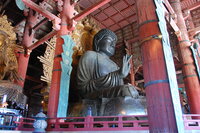
Another place worthy of specific mention is Fushimi-inari which is a Shinto Shrine set on the wooded slopes of Inari-san (the mountain). It is noteworthy because a) it comprises thousands of orange Torri gates lining pathways that meander around the mountain between small shrines, eventually leading to the summit and b) it is Shinto not Buddhist, which means it's free. Which shows it can be done! Inari is dedicated to the gods of cereals (?) and sake (!) and the fox is considered the messenger of Inari, so there are hundreds of stone foxes dotted around the mountain. The foxes range in style from creepy, moss-covered entities to Basil Brush types. Whilst there were thousands of Torri to marvel at, these were outnumbered by the hoards of school children to be annoyed at.
A day trip to Nara saw us visiting Tōdai-ji temple, to see the 15m high, 500 tonne Daibutsu Buddha. This fellow is quite an impressive sight. He's housed in a massive building that was, until 1998, the largest wooden structure in the world. The temple sits in Nara Park which is also famous for its deer, who will bow to you in the hope that you will give them food (on sale at your nearest Buddhist stall). Insert "Buddhism's Dear" joke here! Whilst in the park, Steve picked up a mosquito bite. Megan, always wanting to go one better, got a deer nibble.
Because we had not visited Moron Café or Café Dumbo whilst in Kanazawa, we thought we should take tea and cake in Bolik Café, Nara. Despite the name, it served splendid fare. Megan is beginning to think Steve has a special app on his phone that finds cafés with comedy names™. On the subject of food, we have observed that many restaurants display plastic models of their food in the window. It seemed as though they would be better off not doing this as the models have a very strange appearance and make the food look singularly unappetizing. We ate in a station café at Hanazono and discovered that these models can be incredibly realistic!That's all from Kyoto and its environs. Next up, we are back on the Shinkansen headed for Takamatsu via Himeji castle. More later. To make up for all those words, here's a bunch of pictures.
Some Pictures
